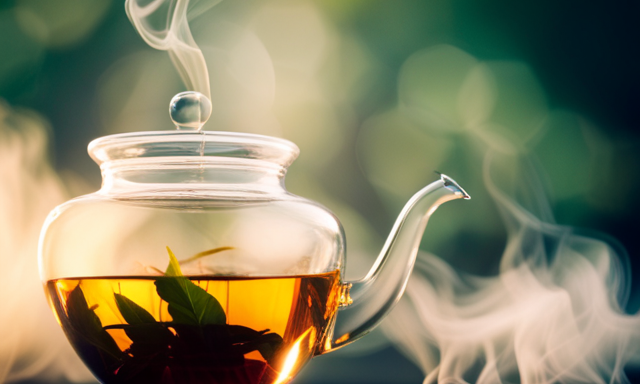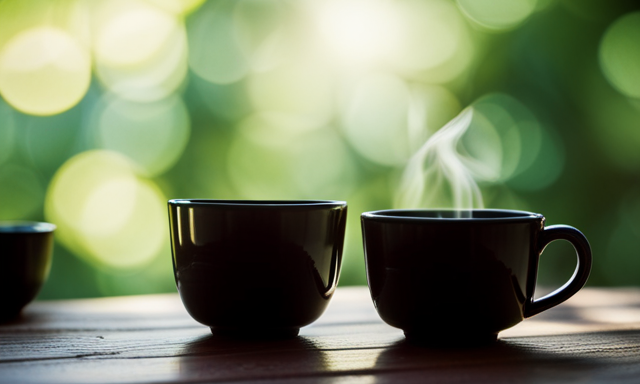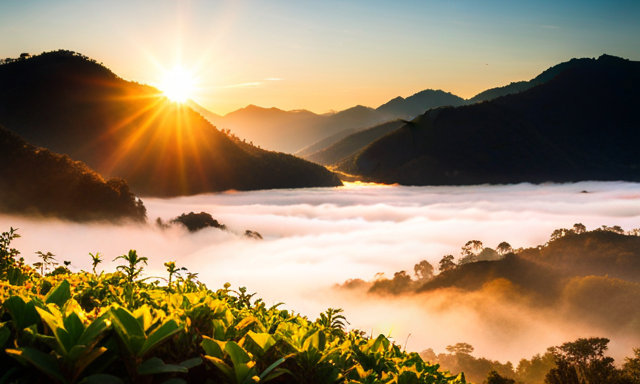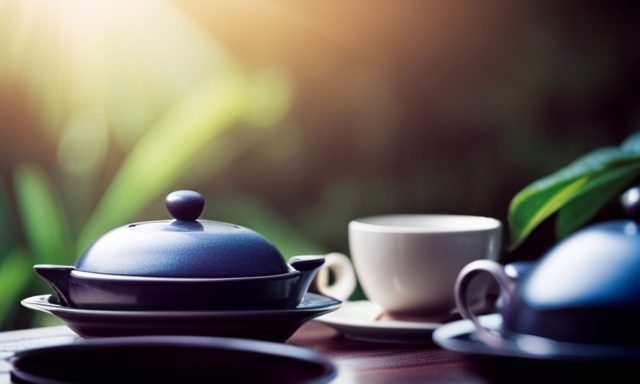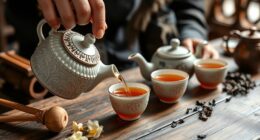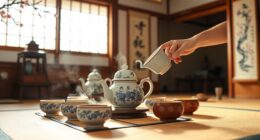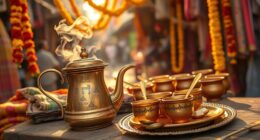As the saying goes, ‘There’s nothing quite like a cup of oolong tea to soothe the soul and awaken the senses.’ And I couldn’t agree more. Oolong tea, with its unique combination of flavors and aromas, is a true delight for tea enthusiasts like myself.
In this article, I will guide you through the art of making oolong tea, sharing with you my knowledge and expertise on the subject.
From choosing the right leaves to preparing the water at the perfect temperature, steeping the tea with precision, and even enhancing the flavor with flowers, fruits, or spices, I will cover every aspect of the process.
I will also introduce you to the essential tools and accessories that make for the perfect tea set. And of course, we will not forget to savor the exquisite aroma and taste of each cup.
But it’s not just about the pleasure of drinking oolong tea. I will also delve into the health benefits it offers and explore the different varieties available.
So, grab your teapot and join me on this delightful journey of oolong tea making.
Key Takeaways
- Oolong tea is a partially oxidized tea with a complex flavor and aroma.
- Choosing the right oolong tea leaves is essential for a delicious cup of tea.
- Paying attention to water temperature and quality is crucial for extracting delicate flavors.
- Steeping time and technique unlock the full aromatic complexities of oolong tea.
Understanding Oolong Tea: A Brief Introduction
Oolong tea, known for its unique flavor and aroma, is a partially oxidized tea that falls between green and black teas on the spectrum of oxidation.
To understand oolong tea, it is important to delve into its rich history and production process. Oolong tea has been enjoyed for centuries, with its origins tracing back to ancient China.
The production process involves withering the tea leaves under the sun, then allowing them to oxidize partially before being gently rolled and dried. This intricate process creates a tea that is complex in flavor and aroma, with a balance of floral, fruity, and toasty notes.
Now that we have a grasp of oolong tea’s background, let’s move on to the next step: choosing the right oolong tea leaves.
Choosing the Right Oolong Tea Leaves
When it comes to selecting the perfect oolong tea leaves, you’re like a discerning connoisseur searching for the rarest gem in a vast treasure trove. Choosing quality oolong tea leaves is essential to ensure a delicious and satisfying cup of tea. Here are some tips to help you make the right choice:
-
Look for tightly rolled leaves: High-quality oolong tea leaves are tightly rolled, which helps to preserve their flavor and aroma.
-
Consider the color: Different oolong teas have different colors, ranging from light green to dark brown. The color can indicate the level of oxidation and can affect the taste.
-
Smell the leaves: Take a deep whiff of the leaves to check for a pleasant and fragrant aroma. This can give you a clue about the flavor profile.
By choosing the right oolong tea leaves, you can enhance your tea-drinking experience. Now, let’s move on to preparing your water: temperature and quality matters.
Preparing Your Water: Temperature and Quality Matters
To truly elevate your tea-drinking experience, it is crucial to pay attention to the temperature and quality of the water used for brewing.
Achieving the perfect water temperature is essential for extracting the delicate flavors of oolong tea. Water that is too hot can scorch the leaves, resulting in a bitter taste, while water that is too cool may not fully unlock the tea’s complex aromas. For oolong tea, a water temperature between 180°F and 200°F (82°C and 93°C) is ideal.
Additionally, the quality of the water plays a significant role in the final taste of your tea. Using filtered or spring water enhances the clarity and purity of the flavors. Remember, the water you choose impacts the overall tea experience.
As we move on to the next section on the art of steeping: time and technique, keep in mind the importance of water temperature and quality.
The Art of Steeping: Time and Technique
Achieving the perfect steeping time and technique is essential for unlocking the full aromatic complexities of a well-brewed cup of oolong. To ensure the best flavor, it is crucial to understand the importance of water temperature and the benefits of using a tea timer. The water temperature plays a significant role in the extraction of flavors from the tea leaves. For oolong tea, the ideal water temperature is around 190-200°F (87-93°C). Steeping the leaves for too long or using water that is too hot can result in a bitter and astringent taste. On the other hand, steeping for too short or using water that is too cool can lead to a weak and flavorless brew. To avoid these pitfalls, using a tea timer can be immensely helpful. It ensures consistency and allows you to experiment with different steeping times to find your preferred taste. In the next section, we will explore how to enhance the flavor of oolong tea by adding flowers, fruits, or spices.
Enhancing the Flavor: Adding Flowers, Fruits, or Spices
Enhancing the flavor: adding flowers, fruits, or spices
Discover how to elevate the taste of your brew by infusing oolong tea with fragrant flowers, juicy fruits, or aromatic spices. Adding these elements to your tea can create a delightful sensory experience.
For a floral infusion, try pairing oolong tea with jasmine blossoms or rose petals. The delicate floral notes will complement the natural flavors of the tea, resulting in a refreshing and aromatic blend.
If you prefer a fruit-infused blend, experiment with citrus fruits like orange or lemon, or try adding berries for a sweeter taste.
For those who enjoy a hint of spice, consider adding cinnamon, ginger, or cardamom to your oolong tea. These warm and exotic flavors will add depth and complexity to your brew.
Now, let’s dive into the different brewing methods: gongfu vs. western style.
Brewing Methods: Gongfu vs. Western Style
To further enhance the flavor of your oolong tea, you can experiment with different brewing methods. Two popular methods are Gongfu and Western style brewing.
Gongfu tea ceremony is a traditional Chinese method that involves steeping the tea leaves multiple times in a small teapot. This method allows for a strong, concentrated brew and brings out the full complexity of oolong’s flavors.
On the other hand, Western style brewing involves steeping the tea leaves in a larger teapot or teacup for a longer period of time. This method produces a milder and more balanced flavor profile.
When it comes to oolong tea, both brewing methods have their merits. Gongfu brewing is ideal for those who appreciate the art and ritual of tea, while Western style brewing is more convenient for everyday enjoyment.
In addition to its delicious taste, oolong tea also offers a range of health benefits. It is known to boost metabolism, aid digestion, and promote relaxation.
Now that we’ve explored the different brewing methods and health benefits, it’s time to delve into the perfect tea set: tools and accessories.
The Perfect Tea Set: Tools and Accessories
Enhance your tea experience with the perfect tea set, complete with all the tools and accessories you need. A well-maintained tea set is essential for brewing the perfect cup of oolong tea. Regular cleaning and proper storage are key to preserving the quality and longevity of your tea set. Additionally, unique tea set designs can add a touch of elegance and style to your tea brewing ritual. From traditional Chinese porcelain sets to modern glass sets, there are endless options to choose from. Consider investing in a set that reflects your personal taste and enhances the overall aesthetic of your tea experience. Now, let’s move on to the next section about enjoying your cup: savoring the aroma and taste.
Enjoying Your Cup: Savoring the Aroma and Taste
Now that you have your perfect tea set and all the necessary tools, it’s time to sit back, relax, and enjoy your cup of oolong tea.
Savoring the aroma and taste of oolong tea is an art in itself, and there are a few techniques that can enhance your experience.
Start by taking a moment to inhale the fragrant steam rising from your cup, allowing the aroma to envelop your senses.
Then, take a small sip, allowing the tea to coat your palate and savor the complex flavors.
Oolong tea pairs well with a variety of foods, such as light desserts, fruits, or even savory dishes. The delicate floral notes and subtle sweetness of oolong tea can complement and enhance the flavors of your meal.
So, take your time, experiment with different pairings, and truly indulge in the sensory delight that is oolong tea.
Moving on to the health benefits of oolong tea…
Health Benefits of Oolong Tea
Indulge in the sensory delight of oolong tea by discovering its numerous health benefits that can nourish your body and mind. Here are three key reasons why oolong tea should be your go-to beverage:
-
Weight Loss: Oolong tea contains polyphenols that help boost metabolism and promote fat oxidation. By incorporating oolong tea into your daily routine, you can support your weight loss goals and maintain a healthy body.
-
Heart Health: The antioxidants found in oolong tea, such as catechins and theaflavins, can help reduce the risk of heart disease. Regular consumption of oolong tea may help lower cholesterol levels and improve overall cardiovascular health.
-
Mental Well-being: Oolong tea contains theanine, an amino acid known for its calming effects. This can help reduce stress and anxiety, promoting a sense of relaxation and mental clarity.
Now that we have explored the health benefits, let’s delve into the exciting world of exploring different varieties of oolong tea.
Exploring Different Varieties of Oolong Tea
Discover the wide range of flavors and aromas that await you as you explore the diverse world of different varieties of oolong tea. Oolong tea originates from various regions, each offering unique characteristics and tastes.
For example, Taiwanese oolong teas are known for their floral and fruity notes, while Chinese oolong teas often have a more earthy and roasted flavor profile. By trying teas from different origins, you can experience the nuances and complexities that make oolong tea so captivating.
In addition to its delicious taste, oolong tea has also been associated with weight loss. Studies have shown that oolong tea can help boost metabolism and increase fat burning, making it a popular choice for those looking to shed some pounds. The polyphenols present in oolong tea are believed to be responsible for its weight loss properties.
So, not only can you enjoy the rich flavors of oolong tea, but it may also support your weight loss journey.
Frequently Asked Questions
Can oolong tea be consumed as iced tea?
Yes, oolong tea can be enjoyed as iced tea. It not only offers a refreshing taste but also provides numerous health benefits. There are various ways to brew oolong tea, allowing you to customize your iced tea experience.
Can oolong tea help with weight loss?
Yes, oolong tea can help with weight loss. Its natural compounds boost metabolism, aid digestion, and reduce fat absorption. Regular consumption of oolong tea benefits weight loss by promoting calorie burning and achieving positive weight loss results.
What is the caffeine content in oolong tea?
The caffeine content in oolong tea varies, but on average, it contains about 25-50 mg per cup. Along with its moderate caffeine content, oolong tea offers numerous health benefits like improved digestion and increased metabolism.
Can oolong tea be re-steeped multiple times?
Absolutely! Re-steeping oolong tea is like finding buried treasure. Not only does it save money, but it also unlocks a whole new world of flavors. To maximize the benefits, use high-quality leaves and experiment with different brewing methods.
Can oolong tea be mixed with other types of tea?
Yes, oolong tea can be mixed with other types of tea to create unique flavors. Mixing oolong tea flavors allows for a variety of taste experiences, while still enjoying the health benefits of oolong tea.
Conclusion
In conclusion, making a delicious cup of oolong tea is an art that requires attention to detail and a passion for the process.
By choosing the right leaves, preparing the water correctly, steeping with precision, and adding personal touches to enhance the flavor, you can create a truly exquisite tea experience.
Remember the old adage, ‘A journey of a thousand miles begins with a single sip.’
With each sip of your perfectly brewed oolong tea, you embark on a flavorful journey that awakens the senses and nourishes the body.
So take your time, savor the aroma, and enjoy the rich taste of this remarkable beverage.

